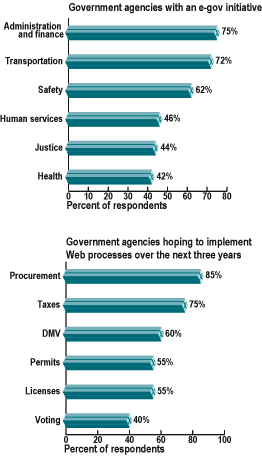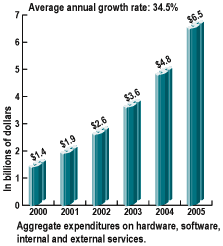ACROSS THE DIGITAL NATION

Over the past two years, electronic government has left an indelible footprint on the marketplace.
Over the past two years, electronic government has left an indelible footprint on the marketplace. E-government has introduced an array of new services, innovative business models and alternative funding mechanisms for the implementation of information technology solutions.Given these dramatic changes, it is important to get a status check of e-government today and where it will be tomorrow.Interestingly, those leading the charge for e-government have been political officials, such as governors and mayors and business line mangers, including agency directors and program managers. These leaders finally understand the importance of IT development and view e-government as a powerful political tool. The vociferous support of governors in Maryland, Utah, Virginia, Washington and other states has spurred government agencies to act and has led to major e-government initiatives. Given this environment, vendors must be able to market to both the information services and the business sides of the government agency.Those agencies that have led the way in putting services online have provided a road map for defining the opportunities in the e-government marketplace. Clearly, administration and finance, and transportation agencies have the most e-government initiatives under way. (See chart top right.)These two agency segments have been the best target for short-term e-government implementation. Other agency segments, such as health and human services, have more complex business issues that will require more time to decipher the impact of e-government.E-government services can be segmented into two categories: government-to-business (G2B) and government-to-citizen (G2C) solutions. Approximately 85 percent of government agencies would like to implement e-procurement over the next three years. (See chart bottom right.)This government-to-business solution is clearly the killer application of e-government, with more than 15 states having e-procurement initiatives in place. The next two major e-government opportunities are Internet tax filing and online drivers' license renewal. At the local government level, there has been significant demand for e-permits and online licensing capabilities. With a click of a mouse, customers can file taxes, renew licenses, obtain a building permit or even download a birth certificate.In order to build these online capabilities, government agencies will need to invest in a wide array of IT products and services. Two immediate areas of investment include ramping up the information technology infrastructure and using consulting services to reconcile business processes with new Web initiatives.Systems integration of offline and online solutions will also become a key area of e-government spending. Government agencies are expected to spend $1.4 billion on e-government solutions this year, with spending growing rapidly to more than $6.5 billion by 2005. (See chart bottom left.)Despite the attention associated with these projects, there is still a question about what these e-government projects will actually deliver. E-government solutions already have proven to be cost effective for processing various government activities, from tax filing to permits to bill payments. Typical savings range from $1 to $5 per transaction.But cost effectiveness isn't the only issue with e-government projects. Another important issue is the relatively small number of transactions and penetration rates currently associated with these online. Despite the low figures, the growth rates connected with these transactions have been skyrocketing. It is critical that government agencies and vendors focus on continuing marketing and awareness campaigns to drive eyeballs after implementation.For the vendor community, the rise of e-government has created new competitive rules that govern success. Here are some tangible recommendations for vendors serving this marketplace:? Focus on security, accessibility and scalability as core marketing messages;? Partner aggressively to round out your portfolio of e-government solutions;? Innovate and develop strategies for the next wave of e-government implementation (e.g., customer relationship management).E-government will remain the main area of IT development within the public-sector marketplace. Government agencies will continue to focus on how to bring more services online and reach out to key customer groups. The next wave of e-government development will focus on customer relationship management initiatives and greater government-to-business development. Similarly, e-government implementation will increasingly be dominated by large states, such as California, which have now deployed key online initiatives.Vendors that serve this marketplace must become versed in the key business issues and technology initiatives surrounding e-government or face being left out of the revolution.



Rishi Sood is a principal analyst with Gartner Dataquest in Mountain View, Calif. His e-mail address is rishi.sood@gartner.com.

Rishi Sood


Rishi Sood is a principal analyst with Gartner Dataquest in Mountain View, Calif. His e-mail address is rishi.sood@gartner.com.

